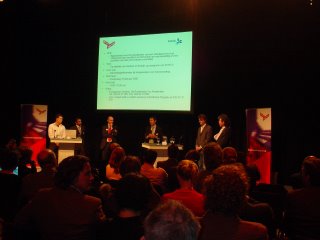 After the presentations of the Crossmedia Café a discussion ensued about the sector. It is a starting segment in the interactive marketing industry, which is tsill struggling with cross-media and cross channeling. Narrowcasting still lacks a clear definition and hard facts about the throughput and effects of the screens. A definition of narrowcast as something opposite to broadcast is too vague. Companies working in the area have started up a joint industry committee in order to design an industry wide, standardised survey into the penetration and the effects of narrowcasting. There first meeting was last Thursday. The Dutch innovation agency Syntens coordinates the initial contacts.
After the presentations of the Crossmedia Café a discussion ensued about the sector. It is a starting segment in the interactive marketing industry, which is tsill struggling with cross-media and cross channeling. Narrowcasting still lacks a clear definition and hard facts about the throughput and effects of the screens. A definition of narrowcast as something opposite to broadcast is too vague. Companies working in the area have started up a joint industry committee in order to design an industry wide, standardised survey into the penetration and the effects of narrowcasting. There first meeting was last Thursday. The Dutch innovation agency Syntens coordinates the initial contacts.That it is business is becoming clear. Three publicly quoted Dutch companies telco KPN, newspaper company De Telegraaf (Media Librium) and beer brewer Heineken (ON) are already involved narrowcasting, having set up subsidiaries or joint ventures. KPN is moving fast by buying up every company with the term narrowcasting in its mission statement. On February 9, 2006 KPN signed the companies: eYe-Display, NN Solutions and QBix. By February 16, 2006 the telco agreed to co-operation with Media Librium; on the same day it appointed a former manager of business market as the manager Narrowcasting. It is clear that KPN wants to go deep in narrowcasting for networking.
Interesting in this developing segment will be the role for content. Especially content creation is a challenging factor of narrow-casting. It is all about experiences, immersive media and ambient technology. It is not the 30s or 40s spot advertisements, but expanded stories, which can be told as short movies. Interactivity is challenging; cameras mounted on screens can offer virtual situations. Narrowcasting is a mix of broadcasting, advertising, (local) news, entertainment and events. The narrowcasting operations will require event organisers with audio-visual experience.
It will be interesting to see how the creative content side of narrowcasting will develop over the next year. Will we have a wonderful world of screens or have audio, video and interactive litter in public spaces and shops: too much noise, inevitable video and intelligent cameras tracking our behaviour, whether we are on a fun shopping spree or just happen to be in a place? In public spaces city councils will like to keep a say in the content and build in controls on interactivity. In shops, the owner will either buy a formula or have a custom made program; but how soliciting will the information be?
Tags: narrow-casting, big screens

No comments:
Post a Comment